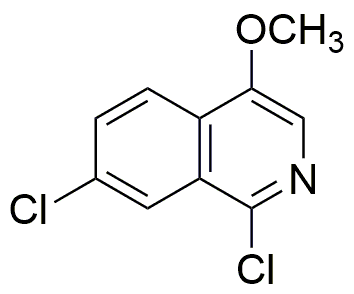1,7-Dichloro-4-methoxyisoquinoline is widely utilized in research focused on:
- Pharmaceutical Development: This compound serves as a valuable intermediate in the synthesis of various pharmaceuticals, particularly in the development of drugs targeting neurological disorders.
- Antimicrobial Research: It has shown potential as an antimicrobial agent, making it useful in the formulation of products aimed at combating bacterial infections.
- Biological Studies: Researchers use it to study its effects on cellular mechanisms, which can lead to insights into cancer treatment and other diseases.
- Material Science: The compound is explored for its properties in creating novel materials, such as polymers or coatings, that require specific chemical stability and reactivity.
- Analytical Chemistry: It is utilized as a standard in analytical methods to quantify related compounds, ensuring accuracy in research and quality control processes.
General Information
Properties
Safety and Regulations
Applications
1,7-Dichloro-4-methoxyisoquinoline is widely utilized in research focused on:
- Pharmaceutical Development: This compound serves as a valuable intermediate in the synthesis of various pharmaceuticals, particularly in the development of drugs targeting neurological disorders.
- Antimicrobial Research: It has shown potential as an antimicrobial agent, making it useful in the formulation of products aimed at combating bacterial infections.
- Biological Studies: Researchers use it to study its effects on cellular mechanisms, which can lead to insights into cancer treatment and other diseases.
- Material Science: The compound is explored for its properties in creating novel materials, such as polymers or coatings, that require specific chemical stability and reactivity.
- Analytical Chemistry: It is utilized as a standard in analytical methods to quantify related compounds, ensuring accuracy in research and quality control processes.
Documents
Safety Data Sheets (SDS)
The SDS provides comprehensive safety information on handling, storage, and disposal of the product.
Product Specification (PS)
The PS provides a comprehensive breakdown of the product’s properties, including chemical composition, physical state, purity, and storage requirements. It also details acceptable quality ranges and the product's intended applications.
Certificates of Analysis (COA)
Search for Certificates of Analysis (COA) by entering the products Lot Number. Lot and Batch Numbers can be found on a product’s label following the words ‘Lot’ or ‘Batch’.
*Catalog Number
*Lot Number
Certificates Of Origin (COO)
This COO confirms the country where the product was manufactured, and also details the materials and components used in it and whether it is derived from natural, synthetic, or other specific sources. This certificate may be required for customs, trade, and regulatory compliance.
*Catalog Number
*Lot Number
Safety Data Sheets (SDS)
The SDS provides comprehensive safety information on handling, storage, and disposal of the product.
DownloadProduct Specification (PS)
The PS provides a comprehensive breakdown of the product’s properties, including chemical composition, physical state, purity, and storage requirements. It also details acceptable quality ranges and the product's intended applications.
DownloadCertificates of Analysis (COA)
Search for Certificates of Analysis (COA) by entering the products Lot Number. Lot and Batch Numbers can be found on a product’s label following the words ‘Lot’ or ‘Batch’.
*Catalog Number
*Lot Number
Certificates Of Origin (COO)
This COO confirms the country where the product was manufactured, and also details the materials and components used in it and whether it is derived from natural, synthetic, or other specific sources. This certificate may be required for customs, trade, and regulatory compliance.


